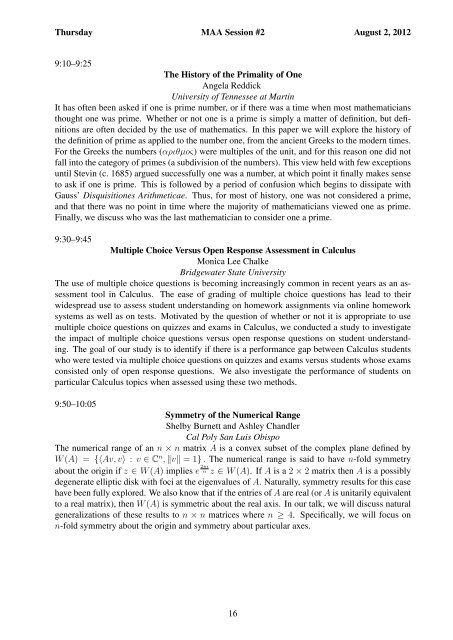Pi Mu Epsilon - Mathematical Association of America
Pi Mu Epsilon - Mathematical Association of America
Pi Mu Epsilon - Mathematical Association of America
Create successful ePaper yourself
Turn your PDF publications into a flip-book with our unique Google optimized e-Paper software.
Thursday MAA Session #2 August 2, 2012<br />
9:10–9:25<br />
The History <strong>of</strong> the Primality <strong>of</strong> One<br />
Angela Reddick<br />
University <strong>of</strong> Tennessee at Martin<br />
It has <strong>of</strong>ten been asked if one is prime number, or if there was a time when most mathematicians<br />
thought one was prime. Whether or not one is a prime is simply a matter <strong>of</strong> definition, but definitions<br />
are <strong>of</strong>ten decided by the use <strong>of</strong> mathematics. In this paper we will explore the history <strong>of</strong><br />
the definition <strong>of</strong> prime as applied to the number one, from the ancient Greeks to the modern times.<br />
For the Greeks the numbers (αριθµoς) were multiples <strong>of</strong> the unit, and for this reason one did not<br />
fall into the category <strong>of</strong> primes (a subdivision <strong>of</strong> the numbers). This view held with few exceptions<br />
until Stevin (c. 1685) argued successfully one was a number, at which point it finally makes sense<br />
to ask if one is prime. This is followed by a period <strong>of</strong> confusion which begins to dissipate with<br />
Gauss’ Disquisitiones Arithmeticae. Thus, for most <strong>of</strong> history, one was not considered a prime,<br />
and that there was no point in time where the majority <strong>of</strong> mathematicians viewed one as prime.<br />
Finally, we discuss who was the last mathematician to consider one a prime.<br />
9:30–9:45<br />
<strong>Mu</strong>ltiple Choice Versus Open Response Assessment in Calculus<br />
Monica Lee Chalke<br />
Bridgewater State University<br />
The use <strong>of</strong> multiple choice questions is becoming increasingly common in recent years as an assessment<br />
tool in Calculus. The ease <strong>of</strong> grading <strong>of</strong> multiple choice questions has lead to their<br />
widespread use to assess student understanding on homework assignments via online homework<br />
systems as well as on tests. Motivated by the question <strong>of</strong> whether or not it is appropriate to use<br />
multiple choice questions on quizzes and exams in Calculus, we conducted a study to investigate<br />
the impact <strong>of</strong> multiple choice questions versus open response questions on student understanding.<br />
The goal <strong>of</strong> our study is to identify if there is a performance gap between Calculus students<br />
who were tested via multiple choice questions on quizzes and exams versus students whose exams<br />
consisted only <strong>of</strong> open response questions. We also investigate the performance <strong>of</strong> students on<br />
particular Calculus topics when assessed using these two methods.<br />
9:50–10:05<br />
Symmetry <strong>of</strong> the Numerical Range<br />
Shelby Burnett and Ashley Chandler<br />
Cal Poly San Luis Obispo<br />
The numerical range <strong>of</strong> an n × n matrix A is a convex subset <strong>of</strong> the complex plane defined by<br />
W (A) = {⟨Av, v⟩ : v ∈ C n , ∥v∥ = 1} . The numerical range is said to have n-fold symmetry<br />
about the origin if z ∈ W (A) implies e 2πi<br />
n z ∈ W (A). If A is a 2 × 2 matrix then A is a possibly<br />
degenerate elliptic disk with foci at the eigenvalues <strong>of</strong> A. Naturally, symmetry results for this case<br />
have been fully explored. We also know that if the entries <strong>of</strong> A are real (or A is unitarily equivalent<br />
to a real matrix), then W (A) is symmetric about the real axis. In our talk, we will discuss natural<br />
generalizations <strong>of</strong> these results to n × n matrices where n ≥ 4. Specifically, we will focus on<br />
n-fold symmetry about the origin and symmetry about particular axes.<br />
16
















